Temporal and Spatial Assessment of Carbon Flux Dynamics: Evaluating Emissions and Sequestration in the Three Northern Protection Forest Project Areas Supported by Google Earth Engine
Abstract
:1. Introduction
2. Data and Methodology
2.1. Overview of the Research Region and Data Source
2.1.1. The Research Region
2.1.2. Data Source
2.2. Methodological Framework

2.2.1. Assessment of Net Ecosystem Productivity
2.2.2. Analyzing Trends in Net Ecosystem Productivity
2.2.3. The Persistence of Net Ecosystem Productivity
3. Results
3.1. Mapping and Temporal Analysis of Net Ecosystem Productivity Using Remote Sensing
3.2. Spatial Patterns of NEP in the Three Northern Protection Forest Project Area
3.3. Correlation between NEP and Environmental Variables in the Three Northern Protection Forest Project Area
3.4. The Relationship between NEP and LUCC in the Three Northern Protection Forest Project Area
3.5. Forecasting Future Patterns in the Three Northern Protection Forest Project Area
4. Conclusions and Discussion
4.1. Conclusions
4.2. Discussion
Author Contributions
Funding
Data Availability Statement
Acknowledgments
Conflicts of Interest
References
- Schimel, D.; Pavlick, R.; Fisher, J.B.; Asner, G.P.; Saatchi, S.; Townsend, P.; Miller, C.; Frankenberg, C.; Hibbard, K.; Cox, P. Observing terrestrial ecosystems and the carbon cycle from space. Glob. Chang. Biol. 2015, 21, 1762–1776. [Google Scholar] [CrossRef]
- Friedlingstein, P.; O’sullivan, M.; Jones, M.W.; Andrew, R.M.; Hauck, J.; Olsen, A.; Peters, G.P.; Peters, W.; Pongratz, J.; Sitch, S. Global carbon budget 2020. Earth Syst. Sci. Data Discuss. 2020, 12, 3269–3340. [Google Scholar] [CrossRef]
- Gang, C.; Zhang, J.; Li, J. The advances in the carbon source/sink researches of typical grassland ecosystem in China. Procedia Environ. Sci. 2011, 10, 1646–1653. [Google Scholar] [CrossRef]
- Zou, C.; Li, H.; Chen, D.; Fan, J.; Liu, Z.; Xu, X.; Li, J.; Wang, Z. Spatial-Temporal Changes of Carbon Source/Sink in Terrestrial Vegetation Ecosystem and Response to Meteorological Factors in Yangtze River Delta Region (China). Sustainability 2022, 14, 10051. [Google Scholar] [CrossRef]
- Turner, D.P.; Ritts, W.D.; Cohen, W.B.; Gower, S.T.; Running, S.W.; Zhao, M.; Costa, M.H.; Kirschbaum, A.A.; Ham, J.M.; Saleska, S.R. Evaluation of MODIS NPP and GPP products across multiple biomes. Remote Sens. Environ. 2006, 102, 282–292. [Google Scholar] [CrossRef]
- Turner, D.P.; Ritts, W.D.; Cohen, W.B.; Gower, S.T.; Zhao, M.; Running, S.W.; Wofsy, S.C.; Urbanski, S.; Dunn, A.L.; Munger, J. Scaling gross primary production (GPP) over boreal and deciduous forest landscapes in support of MODIS GPP product validation. Remote Sens. Environ. 2003, 88, 256–270. [Google Scholar] [CrossRef]
- Sun, Z.; Wang, X.; Zhang, X.; Tani, H.; Guo, E.; Yin, S.; Zhang, T. Evaluating and comparing remote sensing terrestrial GPP models for their response to climate variability and CO2 trends. Sci. Total Environ. 2019, 668, 696–713. [Google Scholar] [CrossRef] [PubMed]
- Cramer, W.; Kicklighter, D.W.; Bondeau, A.; Iii, B.M.; Churkina, G.; Nemry, B.; Ruimy, A.; Schloss, A.L.; The Participants of the Potsdam NPP Model Intercomparison. Comparing global models of terrestrial net primary productivity (NPP): Overview and key results. Glob. Change Biol. 1999, 5, 1–15. [Google Scholar] [CrossRef]
- Wei, X.; Yang, J.; Luo, P.; Lin, L.; Lin, K.; Guan, J. Assessment of the variation and influencing factors of vegetation NPP and carbon sink capacity under different natural conditions. Ecol. Indic. 2022, 138, 108834. [Google Scholar] [CrossRef]
- Matamala, R.; Gonzalez-Meler, M.A.; Jastrow, J.D.; Norby, R.J.; Schlesinger, W. Impacts of fine root turnover on forest NPP and soil C sequestration potential. Science 2003, 302, 1385–1387. [Google Scholar] [CrossRef]
- Lu, X.; Chen, Y.; Sun, Y.; Xu, Y.; Xin, Y.; Mo, Y. Spatial and temporal variations of net ecosystem productivity in Xinjiang Autonomous Region, China based on remote sensing. Front. Plant Sci. 2023, 14, 1146388. [Google Scholar] [CrossRef]
- Obame, R.M.; Copard, Y.; Sebag, D.; Touré, A.A.; Boussafir, M.; Bichet, V.; Garba, Z.; Guillon, R.; Petit, C.; Rajot, J.-L. Carbon sinks in small Sahelian lakes as an unexpected effect of land use changes since the 1960s (Saga Gorou and Dallol Bosso, SW Niger). Catena 2014, 114, 1–10. [Google Scholar] [CrossRef]
- Parton, W.; Morgan, J.; Smith, D.; Del Grosso, S.; Prihodko, L.; Lecain, D.; Kelly, R.; Lutz, S. Impact of precipitation dynamics on net ecosystem productivity. Glob. Chang. Biol. 2012, 18, 915–927. [Google Scholar] [CrossRef]
- Hubau, W.; Lewis, S.L.; Phillips, O.L.; Affum-Baffoe, K.; Beeckman, H.; Cuní-Sanchez, A.; Daniels, A.K.; Ewango, C.E.; Fauset, S.; Mukinzi, J.M. Asynchronous carbon sink saturation in African and Amazonian tropical forests. Nature 2020, 579, 80–87. [Google Scholar] [CrossRef]
- Yuan, G.; Xiaofang, J.; Yuting, H.; Jinghua, Z.; Nan, L. Research progress of CO2 flux in forest ecosystem based on eddy covariance technique: A review. J. Zhejiang AF Univ. 2020, 37, 593–604. [Google Scholar]
- Pei, W.; Yang, Z.; Wang, Y.; Wang, X.; Du, Y. Carbon Sink Characteristics and Regulatory Factors of Qinghai Spruce Forests in the Qilian Mountains. J. Agric. Sci. Technol. 2023, 26, 1–8. [Google Scholar]
- Wang, T.; Wang, X.; Liu, D.; Lv, G.; Ren, S.; Ding, J.; Chen, B.; Qu, J.; Wang, Y.; Piao, S.; et al. The current and future of terrestrial carbon balance over the Tibetan Plateau. Sci. China Earth Sci. 2023, 66, 1493–1503. [Google Scholar] [CrossRef]
- Wang, Y.; Tian, X.; Duan, M.; Zhu, D.; Liu, D.; Zhang, H.; Zhou, M.; Zhao, M.; Jin, Z.; Ding, J.; et al. Optimal design of surface CO2 observation network to constrain China’s land carbon sink. Sci. Bull. 2023, 68, 1678–1686. [Google Scholar] [CrossRef] [PubMed]
- Friend, A.D.; Lucht, W.; Rademacher, T.T.; Keribin, R.; Betts, R.; Cadule, P.; Ciais, P.; Clark, D.B.; Dankers, R.; Falloon, P.D. Carbon residence time dominates uncertainty in terrestrial vegetation responses to future climate and atmospheric CO2. Proc. Natl. Acad. Sci. USA 2014, 111, 3280–3285. [Google Scholar] [CrossRef]
- Dong, L.; Chen, G.-M.; Lin, X.; Liu, Z. Simulation of carbon sequestration and timber production in Larix olgensis plantation based on CO2FIX model. Chin. J. Appl. Ecol. 2022, 33, 2653–2662. [Google Scholar]
- Li, X.; Hai, Q.; Zhu, Z.; Zhang, D.; Shao, Y.; Zhao, Y.; Li, H.; Vandansambuu, B.; Ning, X.; Chen, D. Spatial and Temporal Changes in Vegetation Cover in the Three North Protection Forest Project Area Supported by GEE Cloud Platform. Forests 2023, 14, 295. [Google Scholar] [CrossRef]
- Duan, H.; Yan, C.; Tsunekawa, A.; Song, X.; Li, S.; Xie, J. Assessing vegetation dynamics in the Three-North Shelter Forest region of China using AVHRR NDVI data. Environ. Earth Sci. 2011, 64, 1011–1020. [Google Scholar] [CrossRef]
- Xie, S.; Mo, X.; Hu, S.; Chen, X. Responses of vegetation greenness to temperature and precipitation in the Three-North Shelter Forest Program. Geogr. Res. 2020, 39, 152–165. [Google Scholar]
- Huang, S.; Li, X.; Wu, B.; Pei, L. The Distribution and Drivers of Land Degradation in theThree-North Shelter Forest Region of China during 1982-2006. Acta Geogr. Sin. 2012, 67, 589–598. [Google Scholar]
- Shen, L.; Sun, Y.; Yang, Y.; Jing, Y. Spectrum Characteristic of Vegetation Coverage Change Based on NDVI in the Three-North Shelter Forest Program. Environ. Sci. Technol. 2017, 40, 70–77+106. [Google Scholar]
- Peng, D.; Wu, C.; Zhang, B.; Huete, A.; Zhang, X.; Sun, R.; Lei, L.; Huang, W.; Liu, L.; Liu, X. The influences of drought and land-cover conversion on inter-annual variation of NPP in the Three-North Shelterbelt Program zone of China based on MODIS data. PLoS ONE 2016, 11, e0158173. [Google Scholar] [CrossRef]
- He, Q.; Wang, M.; Liu, K.; Li, K.; Jiang, Z. GPRChinaTemp1km: A high-resolution monthly air temperature dataset for China (1951–2020) based on machine learning. Earth Syst. Sci. Data Discuss. 2021, 1–29. [Google Scholar]
- Peng, S. 1-km Monthly Precipitation Dataset for China (1901–2020); National Tibetan Plateau Data Center: Beijing, China, 2020. [Google Scholar]
- Tang, X.; Fan, S.; Qi, L.; Guan, F.; Du, M.; Zhang, H. Soil respiration and net ecosystem production in relation to intensive management in Moso bamboo forests. Catena 2016, 137, 219–228. [Google Scholar] [CrossRef]
- Wang, C.; Liu, Y.; Li, Z. Effects of ecological water conveyance on the spatial pattern of vegetation carbon sources/sinks in the lower reaches of Tarim River. Arid Land Geogr. 2021, 44, 729–738. [Google Scholar]
- Ye, X.; Wang, Y.; Pan, H.; Bai, Y.; Dong, D.; Yao, H. Spatial-temporal variation and driving factors of vegetation net ecosystem productivity in Qinghai Province. Arid Zone Res. 2022, 39, 1673–1683. [Google Scholar]
- Houghton, R. Terrestrial sources and sinks of carbon inferred from terrestrial data. Tellus B Chem. Phys. Meteorol. 1996, 48, 420–432. [Google Scholar] [CrossRef]
- Pan, J.; Wen, Y. Estimation and spatial-temporal characteristics of carbon sink in the arid region of northwest China. Acta Ecol. Sin. 2015, 35, 7718–7728. [Google Scholar]
- Yue, S.; Wang, C.Y. Applicability of prewhitening to eliminate the influence of serial correlation on the Mann-Kendall test. Water Resour. Res. 2002, 38, 4-1–4-7. [Google Scholar] [CrossRef]
- Hamed, K.H.; Rao, A.R. A modified Mann-Kendall trend test for autocorrelated data. J. Hydrol. 1998, 204, 182–196. [Google Scholar] [CrossRef]
- Wu, D.; Hou, W.; Sang, H.; Zhai, L.; Guo, J. Analysis of spatio-temporal variation of vegetation carbon sources/sinks in Tibet and its impact factors. Sci. Surv. Mapp. 2022, 47, 105–113+134. [Google Scholar]
- Zhou, Y.; Yan, J.; Liu, J.; Wang, Y. Spatio-temporal Variation of NEP in Ecological Zoning on the Loess Plateau and Its Driving Factors from 2000 to 2021. Environ. Sci. Technol. 2023, 1–14. [Google Scholar]
- Han, Z.; Tong, Y.; Wang, G. Spatial-temporal Differentiation and Evolution Trend of Marine Ecological Security in China. Sci. Geogr. Sin. 2022, 42, 1166–1175. [Google Scholar]
- Han, L.; Wang, Q.-F.; Chen, Z.; Yu, G.-R.; Zhou, G.-S.; Chen, S.-P.; Li, Y.-N.; Zhang, Y.-P.; Yan, J.-H.; Wang, H.-M. Spatial patterns and climate controls of seasonal variations in carbon fluxes in China’s terrestrial ecosystems. Glob. Planet. Chang. 2020, 189, 103175. [Google Scholar] [CrossRef]
- Chen, Z.; Yu, G.; Ge, J.; Wang, Q.; Zhu, X.; Xu, Z. Roles of climate, vegetation and soil in regulating the spatial variations in ecosystem carbon dioxide fluxes in the Northern Hemisphere. PLoS ONE 2015, 10, e0125265. [Google Scholar] [CrossRef]
- Zheng, Q.; Wei, H.; Chen, J.; Hou, R.; Zhou, C. Study on Carbon Sink Value Evaluation of Three-north Shelterbelt Program in the Past 40 Years. For. Econ. 2019, 41, 67–73+112. [Google Scholar]
- Cui, Y.; Chen, X.; Chang, Z.; Zheng, G.; Zhu, X. The carbon storage effect of forestry ecological construction and its potential in Ningxia. J. Arid Land Resour. Environ. 2012, 26, 186–190. [Google Scholar]
- Running, S.W.; Nemani, R.R.; Heinsch, F.A.; Zhao, M.; Reeves, M.; Hashimoto, H. A continuous satellite-derived measure of global terrestrial primary production. Bioscience 2004, 54, 547–560. [Google Scholar] [CrossRef]
- Wang, Z. The Research on the Impact of Data and Model Uncertainty on the Simulation of Gross Primary Production of Sample Plots and Global Scale. Master’s Thesis, Central South University of Forestry & Technology, Changsha, China, 2020. [Google Scholar]
- Wu, Q.; Zhang, X.; Jiang, J. Land-Use and Land Cover Change (LUCC) Detection Based on MODIS and CLCD Data and ItsImpact on the Simulation of Vegetation Gross Carbon Assimilation in the Loess Plateau. Geogr. Geo-Inf. Sci. 2023, 39, 30–38. [Google Scholar]
- Zhao, Y.; Ju, Z.; Wu, L. Effects of land use change on net primary productivity. Sci. Surv. Mapp. 2023, 48, 166–175. [Google Scholar]
- Yang, D.; Wang, X. Contribution of climatic change and human activities to changes in net primary productivity in the Loess Plateau. Arid Zone Res. 2022, 39, 584–593. [Google Scholar]
- Jin, K.; Wang, F.; Han, J.; Shi, S.; Ding, W. Contribution of climatic change and human activities to vegetation NDVI change over China during 1982–2015. Acta Geogr. Sin. 2020, 75, 961–974. [Google Scholar]
- Yu, L.; Wu, Z.; Du, Z.; Zhang, H.; Liu, Y. Quantitative analysis of the effects of human activities on vegetation in the Beijing-Tianjin sandstorm source region under the climate change. Chin. J. Appl. Ecol. 2020, 31, 2007–2014. [Google Scholar]
- Du, H.; Song, T.; Zeng, F.; Wang, K.; Peng, W.; Fu, W.; Li, S. Carbon storage and its controlling factors under different vegetation types in depressions between karst hills, southwest China. Acta Ecol. Sin. 2015, 35, 4658–4667. [Google Scholar]
- Zhao, H.; Li, Z.; Zhang, X.; Li, X.; He, S.; Zhao, J. Soil Respiration and Impact Factor of the Different Vegetation Types on Napa Lake Basin. Ecol. Environ. Sci. 2016, 25, 217–222. [Google Scholar]
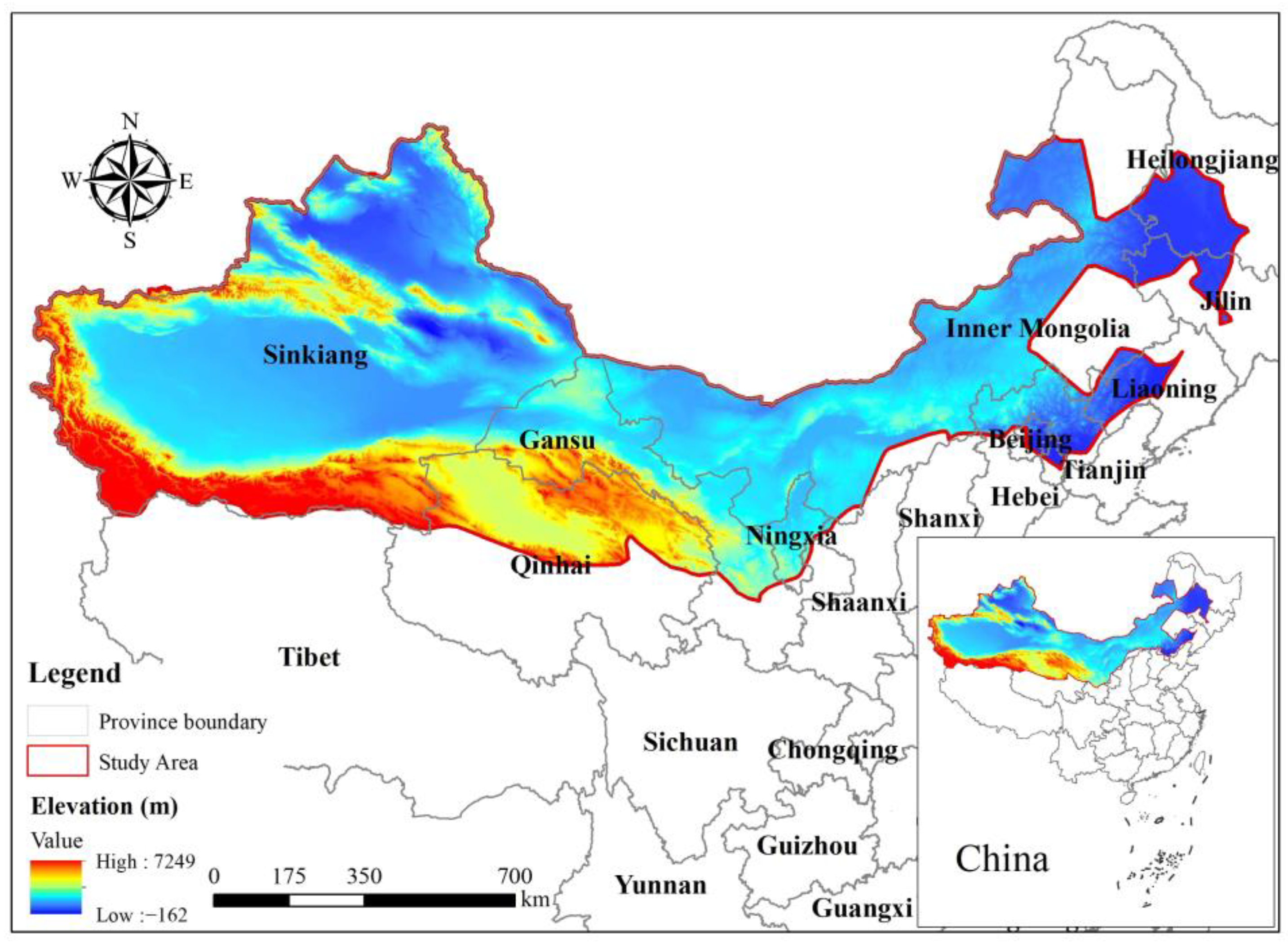
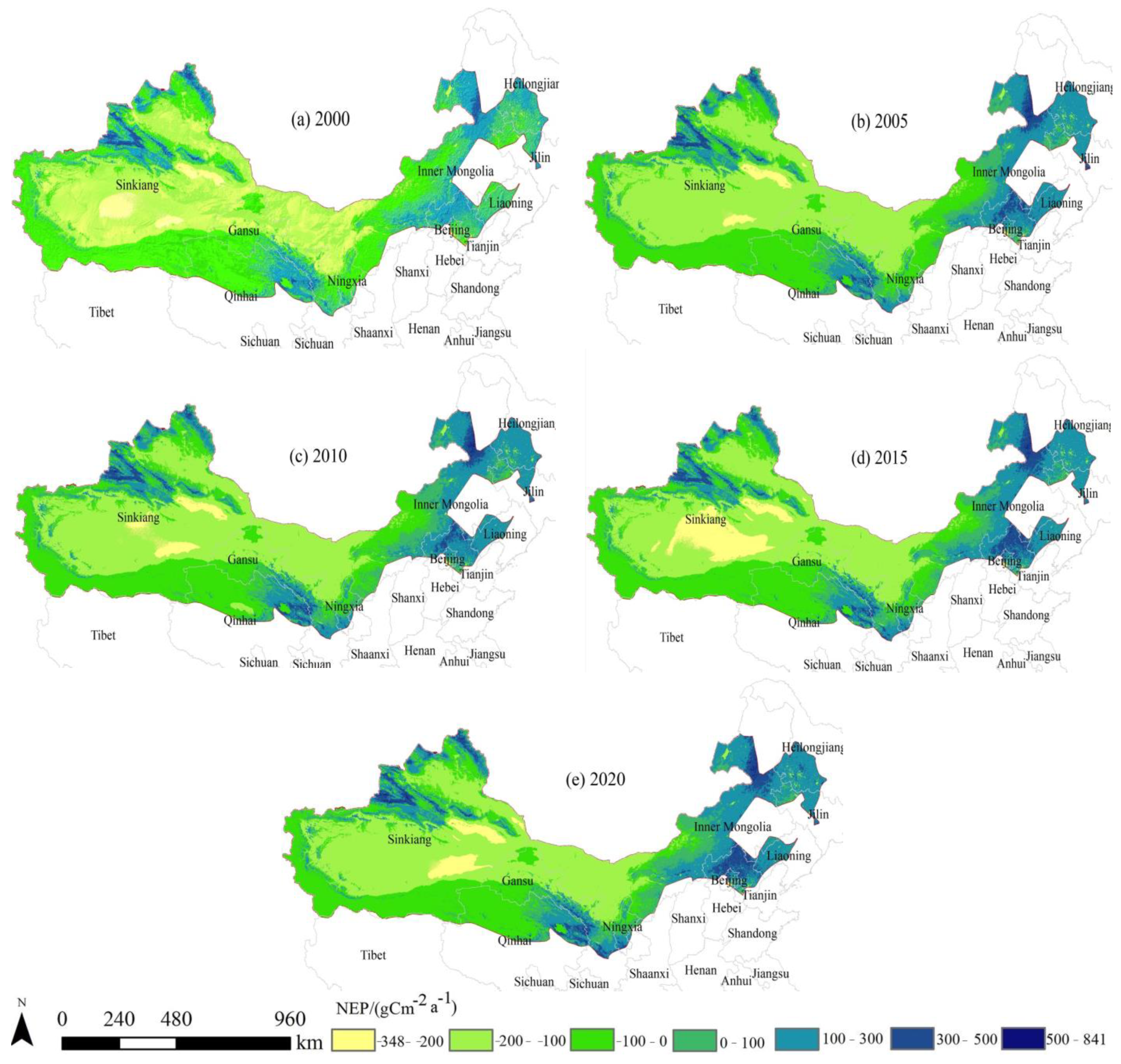
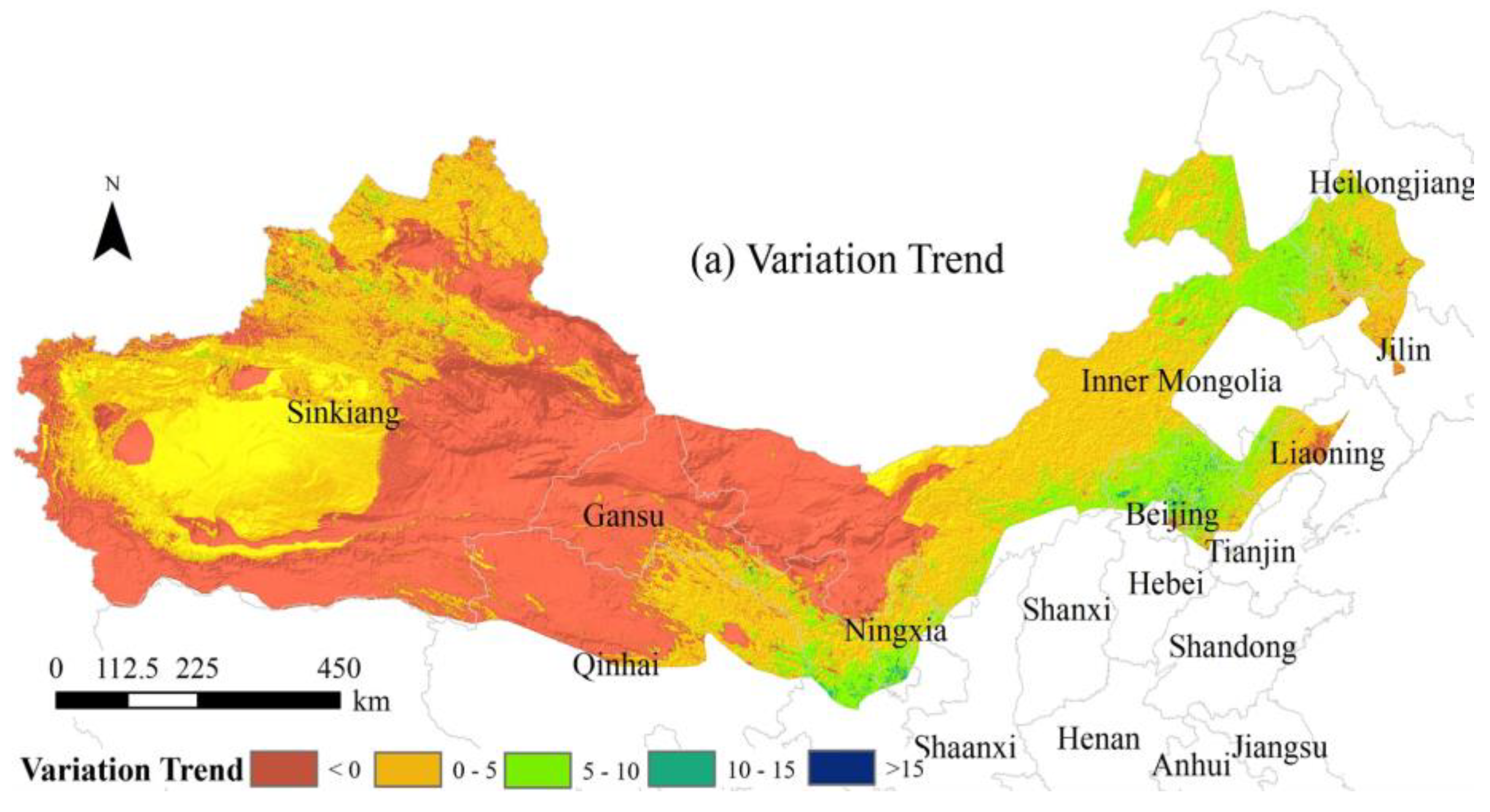
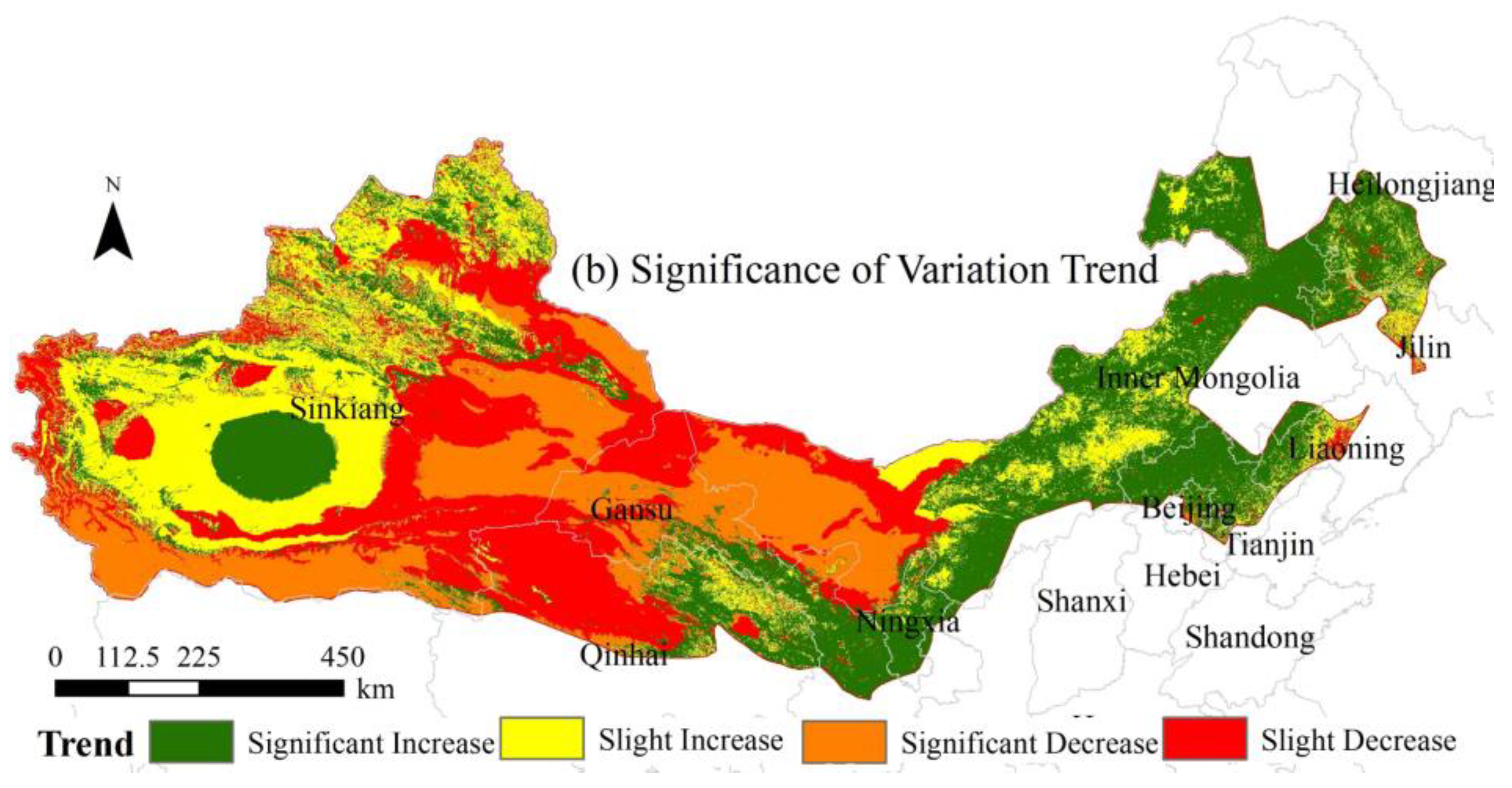
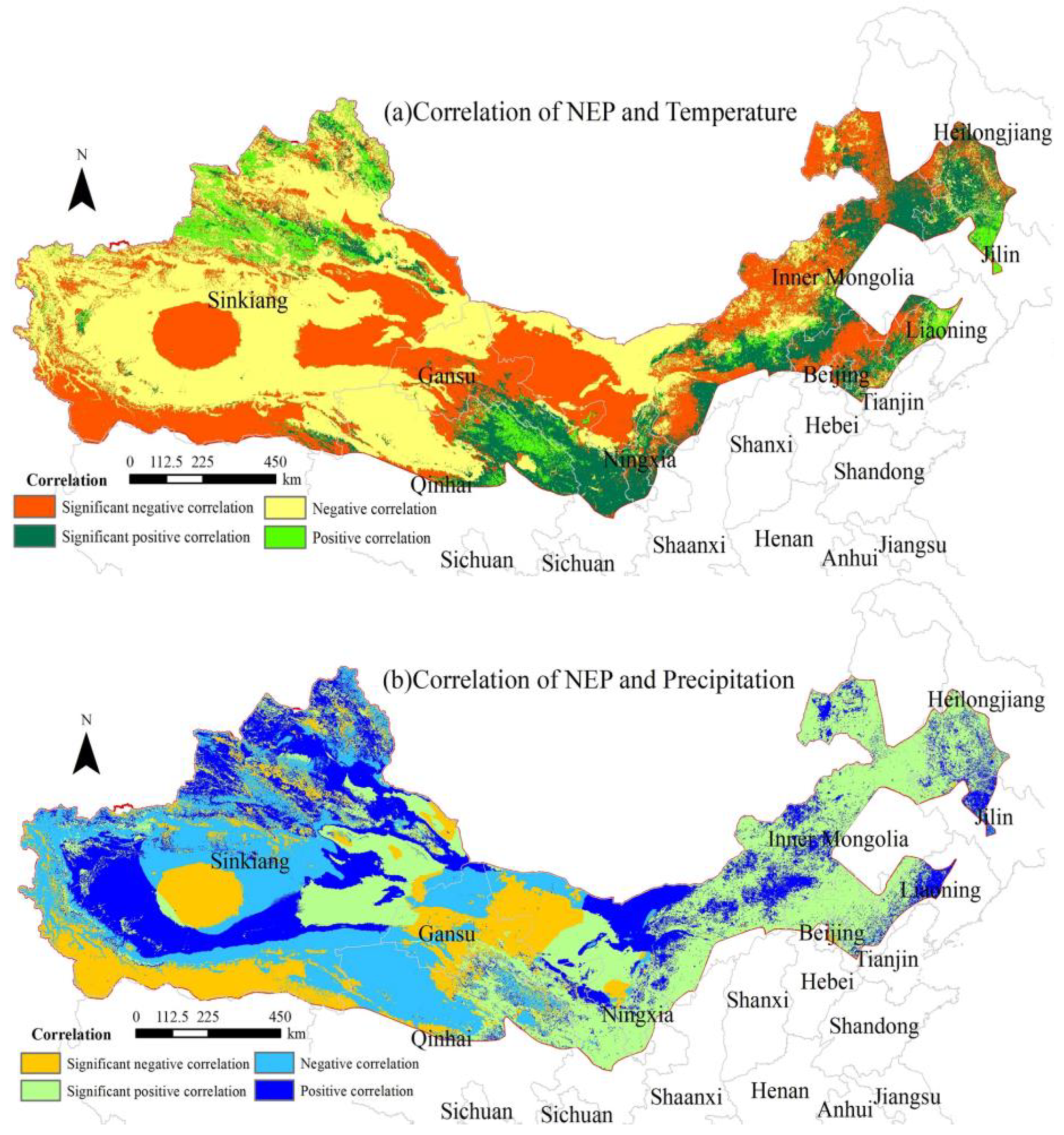
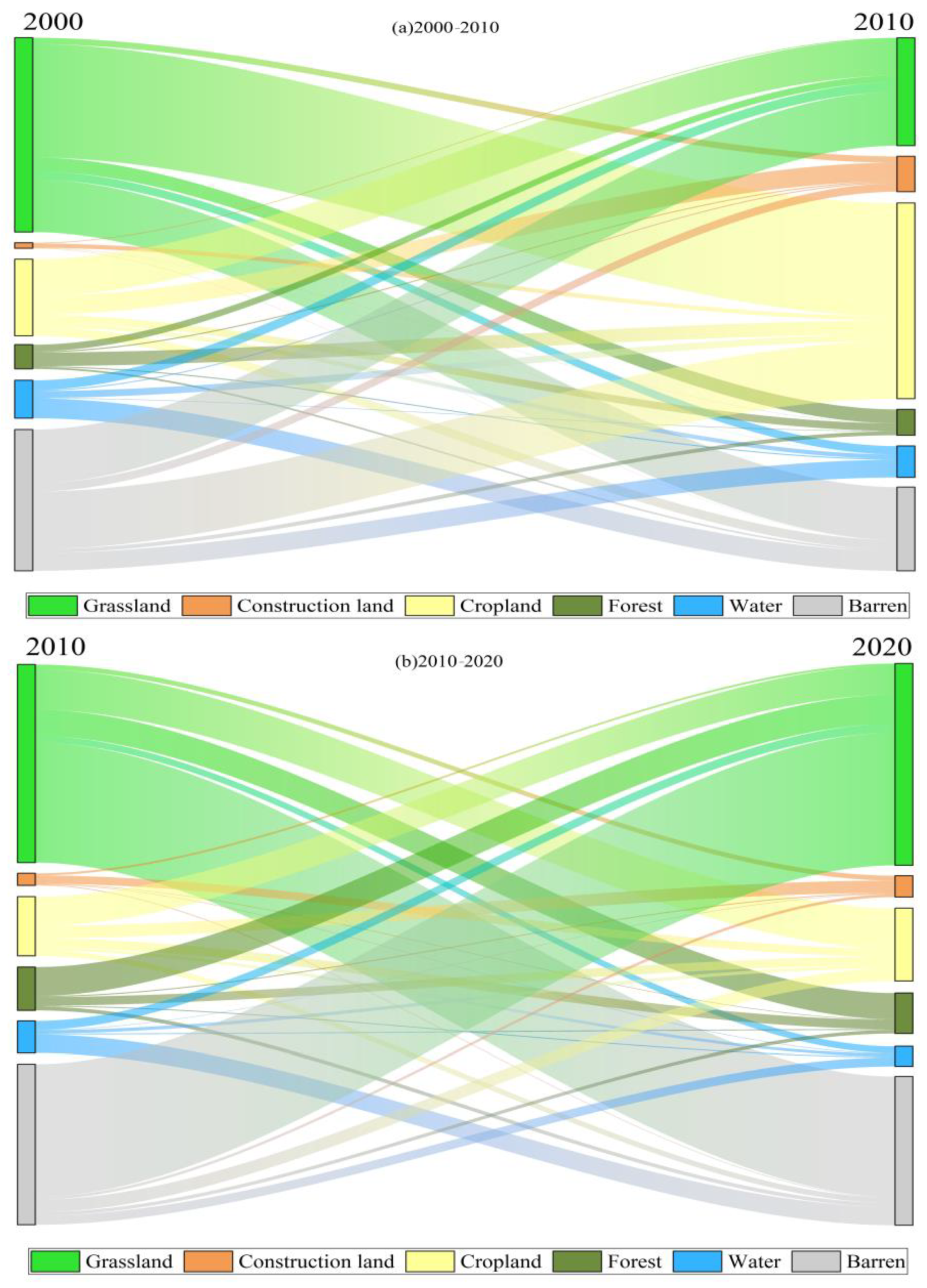
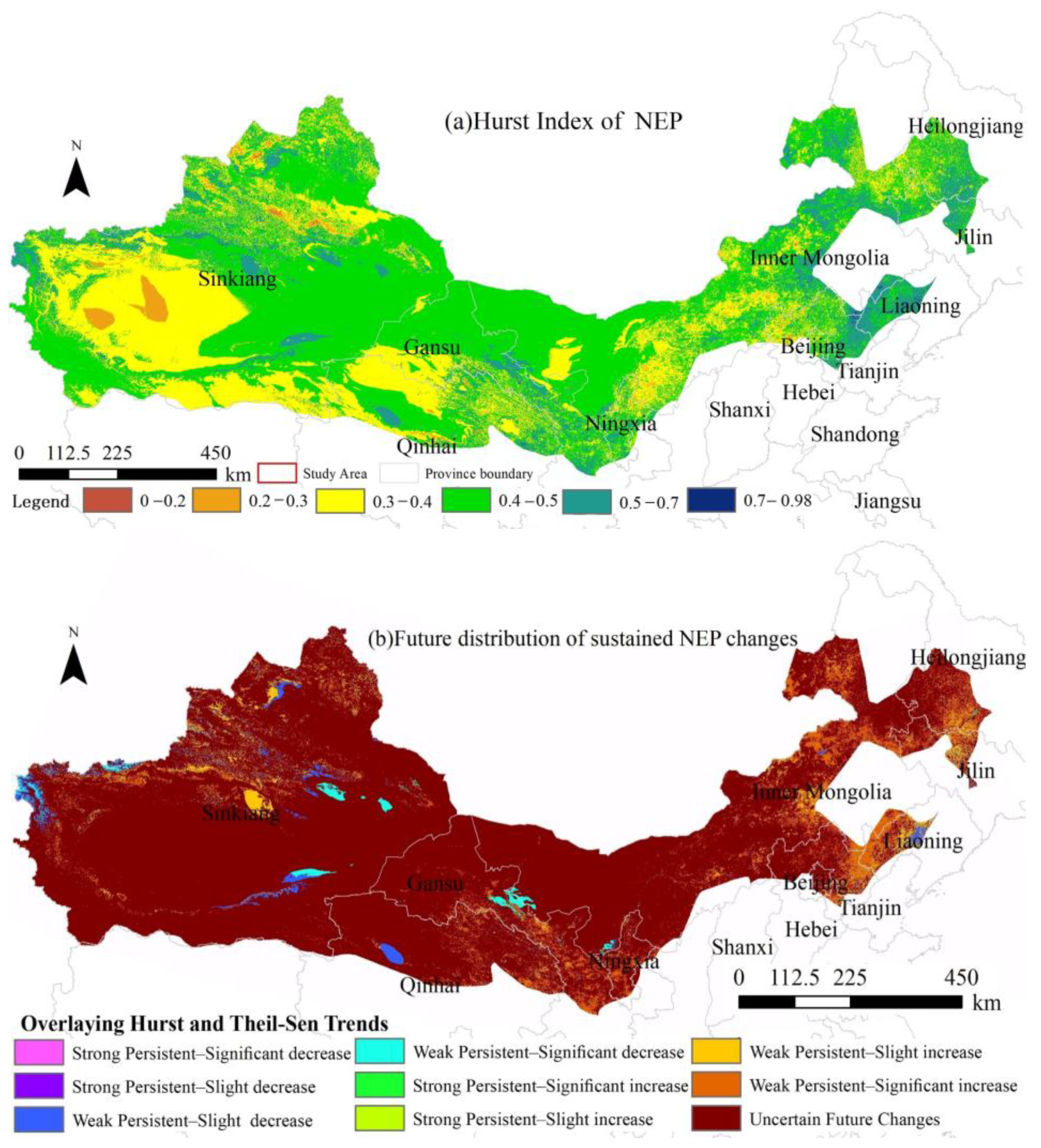
| Data | Source | Access Date | Period |
|---|---|---|---|
| Net Primary Productivity | https://earthengine.google.com | 24 January 2023 | 2000–2020 |
| Temperature | Reference [27] | 5 April 2022 | 2000–2020 |
| Precipitation | Reference [28] | 8 May 2022 | 2000–2020 |
| Geospatial Vector Data | http://www.resdc.cn | 4 November 2022 | - |
| Land Cover Classification | http://www.resdc.cn | 5 November 2022 | 2000–2020 |
Disclaimer/Publisher’s Note: The statements, opinions and data contained in all publications are solely those of the individual author(s) and contributor(s) and not of MDPI and/or the editor(s). MDPI and/or the editor(s) disclaim responsibility for any injury to people or property resulting from any ideas, methods, instructions or products referred to in the content. |
© 2024 by the authors. Licensee MDPI, Basel, Switzerland. This article is an open access article distributed under the terms and conditions of the Creative Commons Attribution (CC BY) license (https://creativecommons.org/licenses/by/4.0/).
Share and Cite
Shao, Y.; Zhu, Q.; Feng, Z.; Sun, L.; Yang, X.; Li, X.; Wang, A.; Yang, F.; Ji, H. Temporal and Spatial Assessment of Carbon Flux Dynamics: Evaluating Emissions and Sequestration in the Three Northern Protection Forest Project Areas Supported by Google Earth Engine. Remote Sens. 2024, 16, 777. https://doi.org/10.3390/rs16050777
Shao Y, Zhu Q, Feng Z, Sun L, Yang X, Li X, Wang A, Yang F, Ji H. Temporal and Spatial Assessment of Carbon Flux Dynamics: Evaluating Emissions and Sequestration in the Three Northern Protection Forest Project Areas Supported by Google Earth Engine. Remote Sensing. 2024; 16(5):777. https://doi.org/10.3390/rs16050777
Chicago/Turabian StyleShao, Yakui, Qin Zhu, Zhongke Feng, Linhao Sun, Xuanhan Yang, Xusheng Li, Aiai Wang, Fei Yang, and Honglin Ji. 2024. "Temporal and Spatial Assessment of Carbon Flux Dynamics: Evaluating Emissions and Sequestration in the Three Northern Protection Forest Project Areas Supported by Google Earth Engine" Remote Sensing 16, no. 5: 777. https://doi.org/10.3390/rs16050777








